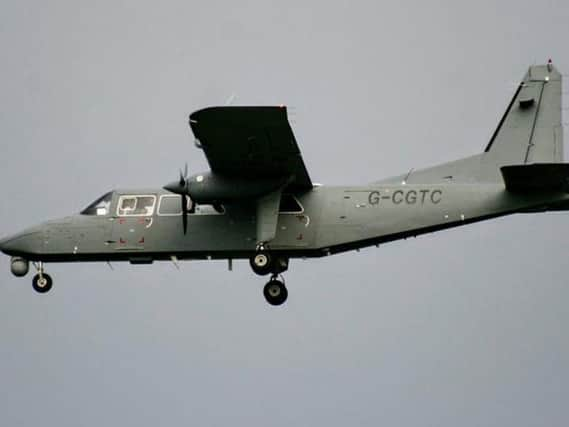PSNI plane glided to Derry after engine failure over Limavady security alert


Further details of the incident which occurred around 10.55pm on November 12, 2020, have been published by the Air Accidents Investigation Branch (AAIB) in its monthly bulletin for October.
Three people - the pilot and two observers - were on board the BN2T-4S Islander, call sign G-CGTC, when the accident occurred.
Advertisement
Hide AdAdvertisement
Hide AdNo one was injured and the aircraft was undamaged, the AAIB bulletin states.
After taking off from Aldergrove it ran into a cold front that had brought extensive cloud and reducing temperatures to the operating area over Limavady.
"The aircraft suffered a double engine failure, likely due to intake icing, while operating in Instrument Meteorological Conditions (IMC) at approximately 7,000 feet above mean sea level (ft/amsl)," the bulletin states.
The report details how the pilot decided to attempt to land the stricken aircraft in Derry rather than attempt a return to Antrim.
Advertisement
Hide AdAdvertisement
Hide Ad"The pilot was aware of the aircraft’s position and decided that his only option was to try to glide to the nearer City of Derry Airport, Eglinton. He established the aircraft in a glide and then completed the engine shutdown and propeller feathering drills. He declared mayday to Aldergrove ATC and asked for vectors toward Eglinton.
"He was aware that Eglinton was closed so asked Aldergrove ATC if they could do anything to get the airfield lighting switched on," the AAIB states.
Remarkably the pilot utilised mapping applications on an iPAD to guide the aircraft into an unlit Eglinton airport.
"During the descent the pilot attempted to restart the engines and 1 minute 30 secs after the second engine failure he was able to restart the right engine at approximately 2,100 ft amsl.
Advertisement
Hide AdAdvertisement
Hide Ad"The aircraft had cleared cloud and the pilot could now see nearby cultural lighting. From the observer’s iPad he could see the aircraft was over Loch Foyle. At approximately 1,500 ft amsl he then attempted a restart of the left engine.
"The first attempt was unsuccessful, which he attributed to not having selected the left engine igniters on. On what he recalled was the second attempt the left engine also restarted. The pilot decided to continue to land at Eglinton.
"Using the iPad map, and with the observer assisting with navigation, he flew the aircraft towards the airport. The pilot recalled that the wet runway surface at Eglinton became visible in reflected cultural lighting as the aircraft flew overhead at approximately 900 ft above ground level (agl).
"Considering that this was too high for a safe approach he flew a left hand circuit to reposition on the centreline for Runway 26. The aircraft descended during the circuit and the pilot recalled seeing the runway from a height of approximately 350 ft agl.
Advertisement
Hide AdAdvertisement
Hide Ad"He then made a powered landing on the unlit runway. After landing the pilot taxied the aircraft to the main parking area and completed the shutdown checks. All on board were uninjured," the report recounts.
In conclusion the AAIB said it is likely the engine anti-icing system was not selected on before entry into cloud with an outside air temperature less than 5°C.
"A build-up of ice in the engine ducts probably caused the engine symptoms noted by the pilot and the subsequent rollbacks and flameouts. The investigation found that the pilot’s limited recent experience in icing conditions was likely to have been a contributory factor, and that circumstances causing stress and fatigue could have affected his performance. Both engines were relit during the descent and a safe landing was made at Eglinton, although the airport was closed," it says.
It is not the first time a PSNI spotter plane has featured in an AAIB report.
Advertisement
Hide AdAdvertisement
Hide AdBack in 2011 another BN2T Islander (G-BSWR) touched down on grass 100 metres short of the Aldergrove runway threshold and collided with the approach lighting system at approximately 2am on Wednesday, July 13, 2011, after observing rioting in Derry on the night of the Twelfth.
According to the official AAIB report of that incident: “The damage to the aircraft was significant. The starboard propeller was damaged, the engine required inspection for possible shock loading, there was impact damage to the nose cone and scratching, denting and a puncture hole in the starboard fuselage. There were also several other holes in the aircraft’s skin."
In relation to the July 11, 2011, accident the cost of repairs was £201,790.73.
Comment Guidelines
National World encourages reader discussion on our stories. User feedback, insights and back-and-forth exchanges add a rich layer of context to reporting. Please review our Community Guidelines before commenting.